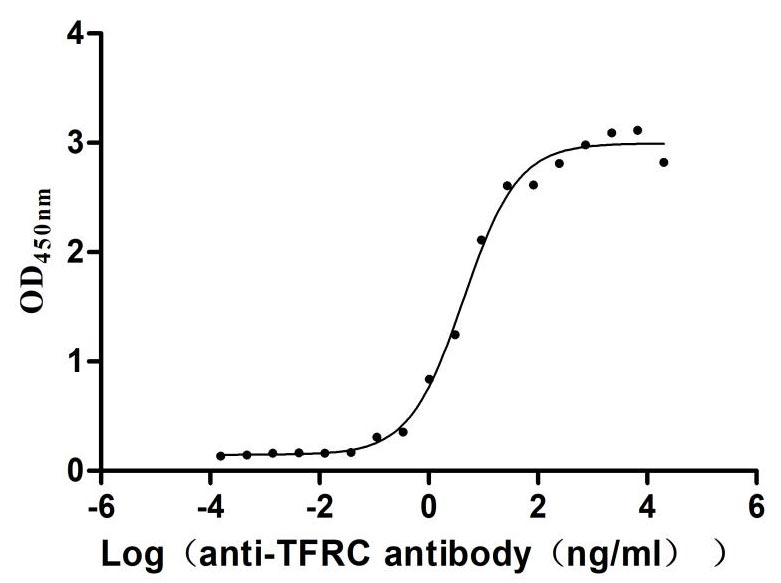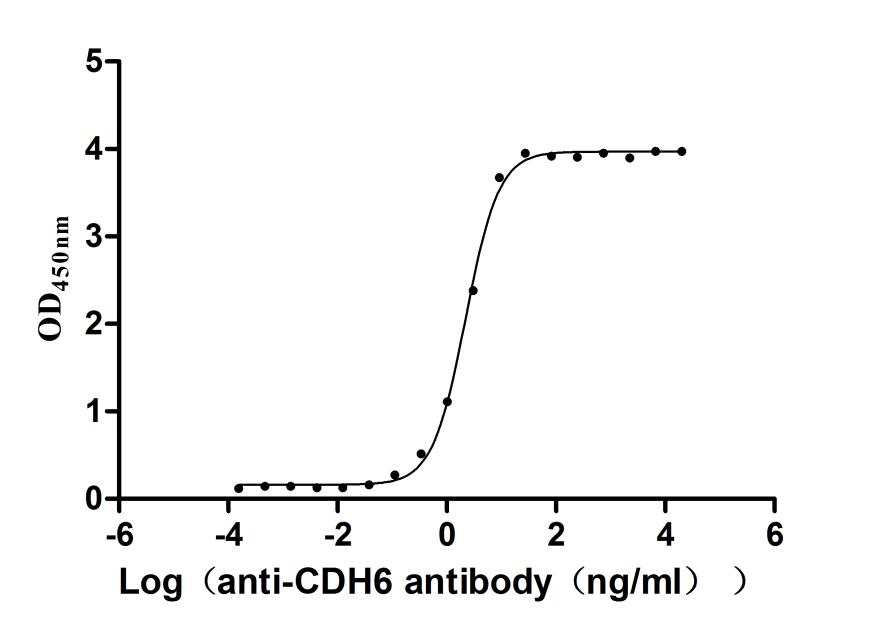Recombinant Rat Dihydropyrimidinase-related protein 2 (Dpysl2)
-
中文名称:大鼠Dpysl2重组蛋白
-
货号:CSB-YP007170RA
-
规格:
-
来源:Yeast
-
其他:
-
中文名称:大鼠Dpysl2重组蛋白
-
货号:CSB-EP007170RA
-
规格:
-
来源:E.coli
-
其他:
-
中文名称:大鼠Dpysl2重组蛋白
-
货号:CSB-EP007170RA-B
-
规格:
-
来源:E.coli
-
共轭:Avi-tag Biotinylated
E. coli biotin ligase (BirA) is highly specific in covalently attaching biotin to the 15 amino acid AviTag peptide. This recombinant protein was biotinylated in vivo by AviTag-BirA technology, which method is BriA catalyzes amide linkage between the biotin and the specific lysine of the AviTag.
-
其他:
-
中文名称:大鼠Dpysl2重组蛋白
-
货号:CSB-BP007170RA
-
规格:
-
来源:Baculovirus
-
其他:
-
中文名称:大鼠Dpysl2重组蛋白
-
货号:CSB-MP007170RA
-
规格:
-
来源:Mammalian cell
-
其他:
产品详情
-
纯度:>85% (SDS-PAGE)
-
基因名:Dpysl2
-
Uniprot No.:
-
别名:Dpysl2Dihydropyrimidinase-related protein 2; DRP-2; Collapsin response mediator protein 2; CRMP-2; Turned on after division 64 kDa protein; TOAD-64
-
种属:Rattus norvegicus (Rat)
-
蛋白长度:Full length protein
-
表达区域:1-572
-
氨基酸序列MSYQGKKNIP RITSDRLLIK GGKIVNDDQS FYADIYMEDG LIKQIGENLI VPGGVKTIEA HSRMVIPGGI DVHTRFQMPD QGMTSADDFF QGTKAALAGG TTMIIDHVVP EPGTSLLAAF DQWREWADSK SCCDYSLHVD ITEWHKGIQE EMEALVKDHG VNSFLVYMAF KDRFQLTDSQ IYEVLSVIRD IGAIAQVHAE NGDIIAEEQQ RILDLGITGP EGHVLSRPEE VEAEAVNRSI TIANQTNCPL YVTKVMSKSA AEVIAQARKK GTVVYGEPIT ASLGTDGSHY WSKNWAKAAA FVTSPPLSPD PTTPDFLNSL LSCGDLQVTG SAHCTFNTAQ KAVGKDNFTL IPEGTNGTEE RMSVIWDKAV VTGKMDENQF VAVTSTNAAK VFNLYPRKGR ISVGSDADLV IWDPDSVKTI SAKTHNSALE YNIFEGMECR GSPLVVISQG KIVLEDGTLH VTEGSGRYIP RKPFPDFVYK RIKARSRLAE LRGVPRGLYD GPVCEVSVTP KTVTPASSAK TSPAKQQAPP VRNLHQSGFS LSGAQIDDNI PRRTTQRIVA PPGGRANITS LG
-
蛋白标签:Tag type will be determined during the manufacturing process.
The tag type will be determined during production process. If you have specified tag type, please tell us and we will develop the specified tag preferentially. -
产品提供形式:Lyophilized powder
Note: We will preferentially ship the format that we have in stock, however, if you have any special requirement for the format, please remark your requirement when placing the order, we will prepare according to your demand. -
复溶:We recommend that this vial be briefly centrifuged prior to opening to bring the contents to the bottom. Please reconstitute protein in deionized sterile water to a concentration of 0.1-1.0 mg/mL.We recommend to add 5-50% of glycerol (final concentration) and aliquot for long-term storage at -20℃/-80℃. Our default final concentration of glycerol is 50%. Customers could use it as reference.
-
储存条件:Store at -20°C/-80°C upon receipt, aliquoting is necessary for mutiple use. Avoid repeated freeze-thaw cycles.
-
保质期:The shelf life is related to many factors, storage state, buffer ingredients, storage temperature and the stability of the protein itself.
Generally, the shelf life of liquid form is 6 months at -20°C/-80°C. The shelf life of lyophilized form is 12 months at -20°C/-80°C. -
货期:Delivery time may differ from different purchasing way or location, please kindly consult your local distributors for specific delivery time.Note: All of our proteins are default shipped with normal blue ice packs, if you request to ship with dry ice, please communicate with us in advance and extra fees will be charged.
-
注意事项:Repeated freezing and thawing is not recommended. Store working aliquots at 4°C for up to one week.
-
Datasheet :Please contact us to get it.
靶点详情
-
功能:Plays a role in neuronal development and polarity, as well as in axon growth and guidance, neuronal growth cone collapse and cell migration. Necessary for signaling by class 3 semaphorins and subsequent remodeling of the cytoskeleton. May play a role in endocytosis.
-
基因功能参考文献:
- The results of the present study suggested that TLR4 may promote the phosphorylation of CRMP2 via the activation of ROCKII in MCAO rats, which further characterizes the pathological mechanism of TLR4 in stroke, and that modulation of TLR4 could be a potential target to limit secondary poststroke brain damage. PMID: 29749502
- The cytosolic regulatory protein collapsin response mediator protein 2 (CRMP2) regulates activity of voltage-gated calcium (specifically N-type or CaV2.2) and voltage-gated sodium channels PMID: 28809766
- -overexpression effectively protected the proximal axon from fragmentation within 6 hours after crush. Finally, a proteomic analysis of the optic nerve was performed at 6 hours after crush, which identified further proteins regulated during acute axonal d PMID: 27845394
- CRMP2 expression was significantly upregulated, particularly in the ruptured site of Achilles tendon tissues derived from animals in the mobilization group compared with the immobilization group (0.32+/-0.00 vs. 0.08+/-0.00; P<0.05). Active mobilization may promote Achilles tendon healing via upregulation of CRMP2 protein expression. PMID: 28677754
- cross-talk between distinct CRMP2 posttranslational modifications is a key factor in determining NaV1.7 trafficking and localization PMID: 27940916
- Results indicate that activation of the CDK5/CRMP2 pathway may mediate sevoflurane-induced dendritic development abnormalities in the cortical neurons. The physiological significance of these findings remains to be determined. PMID: 28445771
- The results of this study suggested that the neuroplasticity effect of BMSCs on cerebral ischemia may be associated with the phosphorylated modulation of CRMP2. PMID: 27765673
- Data suggest collapsin response mediator proteins (CRMP) CRMP2 and CRMP4 form complexes to bridge microtubules and actin and work cooperatively to regulate growth cone development and axonal elongation. PMID: 26064693
- The present findings demonstrated that the downregulation of genes such as Dpysl2 and Dypsl3 in a rat model of prenatal stress may affect subsequent behavioral changes PMID: 25847191
- The CRMP2 deSUMOylation by SUMO proteases SENP1 and SENP2 normalized calcium influx to those in the CRMP2AAA mutant. PMID: 23510938
- CRMP2 interacts with NCX and NMDAR and TAT-CBD3 protects against glutamate-induced Ca(2+) dysregulation most likely via suppression of both NMDAR and NCX activities PMID: 24474686
- CRMP-2-dependent regulation of ROCK II activity is mediated through interaction of the CRMP-2L N terminus with the ROCK II catalytic domain as well as by GSK3-dependent phosphorylation of CRMP-2. PMID: 24036111
- RGMa inhibits axon growth by phosphorylating CRMP-2 via both Rho-kinase and GSK-3beta signaling pathways. PMID: 23275173
- Disruption of NMDA receptor-CRMP-2 signaling protects against focal cerebral ischemic damage in the rat middle cerebral artery occlusion model PMID: 22373559
- CRMP2B and ARPC5 may participate in CNS injury mediated by hypothyroidism by inducing neurite outgrowth inhibition and cytoskeletal protein disorganization. PMID: 23459330
- a new insight into CRMP-2 as a controller of myosin II-mediated cellular functions through the inhibition of ROCK II in nonneuronal cells PMID: 22431514
- HCNP-pp, in association with unphosphorylated and/or pSer522-CRMP-2, plays an important role in presynaptic function in the mature hippocampus. PMID: 23276635
- Cdk5-phosphorylated CRMP-2 had increased association with CaV2.2. PMID: 23022559
- Found that the Akt/glycogen synthase kinase-3beta /collapsin response mediator protein 2 pathway mediates axonal injury in neonatal rat brain after hypoxic-ischemia. PMID: 22554777
- These findings suggest, for the first time, that lacosamide's mode of action involves interactions with CRMP2 to inhibit posttraumatic axon sprouting. PMID: 22433297
- These findings suggest that HCNP-pp, in association with CRMP-2, plays an important role in presynaptic function in the hippocampus PMID: 22542739
- findings suggest a major role of phosphorylated CRMP-2 as a mechanism involved in process retraction induced by reactive oxygen species PMID: 22443207
- Activated CRMP2 plays an important role in neuronal plasticity in periventricular leukomalacia in 3-day-old rats. PMID: 21333637
- the antinociceptive potential of a peptide disrupting the N-type calcium channel-CRMP-2 signaling complex. PMID: 21829088
- Neuroprotection against traumatic brain injury by a peptide derived from the collapsin response mediator protein 2 (CRMP2). PMID: 21832084
- PIPP and CRMP2 exert opposing roles in promoting axon selection and neurite elongation and the complex between these proteins serves to regulate the localization of effectors that promote neurite extension. PMID: 21550974
- CRMP-2 expression increased in the course of neurite growth and the fact that permanently high CRMP-2 expression interferes with neurite outgrowth; high expression levels of CRMP-2 inhibit the initiation of neurite outgrowth PMID: 20453694
- Results identify key CRMP-2 residues that can coordinate LCM binding thus making it more effective on its primary clinical target. PMID: 20538611
- Hippocampal coexpression of wild-type (wt)CRMP2 and protein phosphatase 2A (PP2A) increases axon length compared with wtPP2A alone. PMID: 20220019
- CRMP-2 regulates axonal growth and branching as a partner of the tubulin heterodimer PMID: 12134159
- The present study suggests that CRMP-2 has potent neurite elongation activity in nerve regeneration in vivo PMID: 12887701
- Inhibition of CRMP-2 stopped endocytosis of L1 at axonal growth cones and suppressed axon growth, suggesting that CRMP-2 is involved in polarized Numb-mediated endocytosis of proteins such as L1. PMID: 12942088
- These results indicate that the CRMP-2/Kinesin-1 complex regulates soluble tubulin transport to the distal part of the growing axon. PMID: 15935053
- collapsin response mediator protein-2 is an important candidate controlling ischemic stroke PMID: 16189471
- CRMP-2 transports the Sra-1/WAVE1 complex to axons in a kinesin-1-dependent manner and thereby regulates axon outgrowth and formation PMID: 16260607
- Taken together, these results suggest that Ras plays critical roles in establishing neuronal polarity upstream of the PI3-kinase/Akt/GSK-3beta/CRMP-2 pathway and mitogen-activated protein kinase cascade. PMID: 16343426
- collapsin response mediator protein-2 PMID: 17051644
- association of neurofibromin and CRMP-2 is essential for neuronal cell differentiation PMID: 18218617
- Since both neurofibromin and CRMP proteins are involved in proliferation and axonal morphogenesis, these results suggest that the interaction with CRMPs contributes to the function of neurofibromin in tumorigenesis and neuronal morphogenesis. PMID: 18313395
- post-transcriptional processing of CRMP2 together with its nuclear localization may be an important key in the regulation of neurite outgrowth in brain development PMID: 18332147
- relative resistance to phosphatases might be a common feature of Cdk5 substrates and could contribute to the hyperphosphorylation of CRMP2 and Tau observed in Alzheimer disease PMID: 18460467
- Data suggest that collapsin response mediator protein-2 (CRMP-2) is a novel calmodulin-binding protein and that CaM binding may play an important role in regulating CRMP-2 functions. PMID: 19151921
- Upregulation of Dpysl2 and Spna2 expression in hypertrophic cells in the penumbra regions of cortex and striatum of stroke brain indicates an early neuronal defense mechanism involving active neuronal repair, regeneration and development. PMID: 19524114
- Local translation of CRMP2 and Tau, regulated by mTOR-p70S6K, is critical for the specification of neuronal polarity. PMID: 19648118
- CRMP-2 and Cav2.2 interaction modulates Ca(2+) influx into nerve terminals. PMID: 19755421
显示更多
收起更多
-
亚细胞定位:Cytoplasm, cytosol. Cytoplasm, cytoskeleton. Membrane.
-
蛋白家族:Metallo-dependent hydrolases superfamily, Hydantoinase/dihydropyrimidinase family
-
数据库链接:
KEGG: rno:25416
STRING: 10116.ENSRNOP00000012996
UniGene: Rn.2889
Most popular with customers
-
Recombinant Human Tyrosine-protein kinase Mer (MERTK), partial (Active)
Express system: Mammalian cell
Species: Homo sapiens (Human)
-
Recombinant Human Nectin-4 (NECTIN4), partial (Active)
Express system: Mammalian cell
Species: Homo sapiens (Human)
-
Recombinant Human Transferrin receptor protein 1 (TFRC), partial (Active)
Express system: Mammalian cell
Species: Homo sapiens (Human)
-
Recombinant Human CD81 antigen (CD81), partial (Active)
Express system: Mammalian cell
Species: Homo sapiens (Human)
-
Recombinant Macaca fascicularis Cadherin 6(CDH6),partial (Active)
Express system: Mammalian cell
Species: Macaca fascicularis (Crab-eating macaque) (Cynomolgus monkey)
-
Recombinant Human Tumor necrosis factor ligand superfamily member 15(TNFSF15) (Active)
Express system: Mammalian cell
Species: Homo sapiens (Human)







-AC1.jpg)










